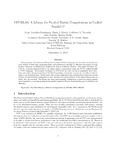Mostrar o rexistro simple do ítem
UPCBLAS: a library for parallel matrix computations in Unified Parallel C
| dc.contributor.author | González-Domínguez, Jorge | |
| dc.contributor.author | Martín, María J. | |
| dc.contributor.author | Taboada, Guillermo L. | |
| dc.contributor.author | Touriño, Juan | |
| dc.contributor.author | Doallo, Ramón | |
| dc.contributor.author | Mallón, Damián A. | |
| dc.contributor.author | Wibecan, Brian | |
| dc.date.accessioned | 2019-02-11T19:46:25Z | |
| dc.date.available | 2019-02-11T19:46:25Z | |
| dc.date.issued | 2012-09-25 | |
| dc.identifier.citation | González‐Domínguez, J. , Martín, M. J., Taboada, G. L., Touriño, J. , Doallo, R. , Mallón, D. A. and Wibecan, B. (2012), UPCBLAS: a library for parallel matrix computations in Unified Parallel C. Concurrency Computat.: Pract. Exper., 24: 1645-1667. doi:10.1002/cpe.1914 | es_ES |
| dc.identifier.issn | 1532-0626 | |
| dc.identifier.issn | 1532-0634 | |
| dc.identifier.uri | http://hdl.handle.net/2183/21712 | |
| dc.description | This is the peer reviewed version of the following article: González‐Domínguez, J. , Martín, M. J., Taboada, G. L., Touriño, J. , Doallo, R. , Mallón, D. A. and Wibecan, B. (2012), UPCBLAS: a library for parallel matrix computations in Unified Parallel C. Concurrency Computat.: Pract. Exper., 24: 1645-1667. doi:10.1002/cpe.1914, which has been published in final form at https://doi.org/10.1002/cpe.1914. This article may be used for non-commercial purposes in accordance with Wiley Terms and Conditions for Use of Self-Archived Versions. | es_ES |
| dc.description.abstract | [Abstract] The popularity of Partitioned Global Address Space (PGAS) languages has increased during the last years thanks to their high programmability and performance through an efficient exploitation of data locality, especially on hierarchical architectures such as multicore clusters. This paper describes UPCBLAS, a parallel numerical library for dense matrix computations using the PGAS Unified Parallel C language. The routines developed in UPCBLAS are built on top of sequential basic linear algebra subprograms functions and exploit the particularities of the PGAS paradigm, taking into account data locality in order to achieve a good performance. Furthermore, the routines implement other optimization techniques, several of them by automatically taking into account the hardware characteristics of the underlying systems on which they are executed. The library has been experimentally evaluated on a multicore supercomputer and compared with a message‐passing‐based parallel numerical library, demonstrating good scalability and efficiency. | es_ES |
| dc.description.sponsorship | Ministerio de Ciencia e Innovación; TIN2010-16735 | es_ES |
| dc.description.sponsorship | Ministerio de Educación; AP2008-01578 | es_ES |
| dc.language.iso | eng | es_ES |
| dc.publisher | John Wiley & Sons Ltd. | es_ES |
| dc.relation.uri | https://doi.org/10.1002/cpe.1914 | es_ES |
| dc.subject | Parallel Library | es_ES |
| dc.subject | matrix computations | es_ES |
| dc.subject | PGAS | es_ES |
| dc.subject | UPC | es_ES |
| dc.subject | BLAS | es_ES |
| dc.title | UPCBLAS: a library for parallel matrix computations in Unified Parallel C | es_ES |
| dc.type | info:eu-repo/semantics/article | es_ES |
| dc.rights.access | info:eu-repo/semantics/openAccess | es_ES |
| UDC.journalTitle | Concurrency and Computation: Practice & Experience | es_ES |
| UDC.volume | 24 | es_ES |
| UDC.issue | 14 | es_ES |
| UDC.startPage | 1645 | es_ES |
| UDC.endPage | 1667 | es_ES |
| dc.identifier.doi | 10.1002/cpe.1914 |
Ficheiros no ítem
Este ítem aparece na(s) seguinte(s) colección(s)
-
GI-GAC - Artigos [190]






